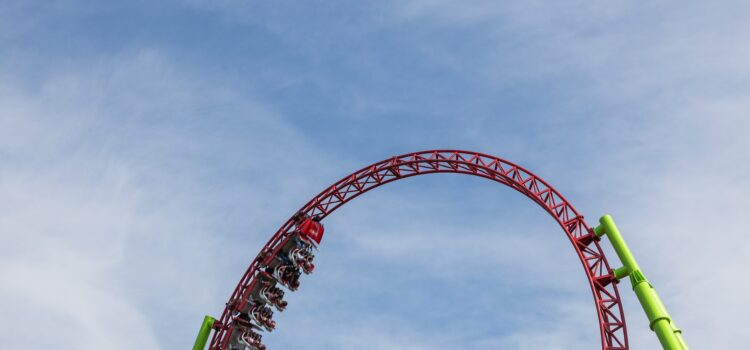

This article is an excerpt from the Shortform summary of "Thinking in Systems" by Donella H. Meadows. Shortform has the world's best summaries of books you should be reading.
Like this article? Sign up for a free trial here .
What is a balancing loop? What kids of systems include balancing loops?
A balancing loops is a type of feedback loop that exists within a system. Balancing loops are formed when the stock of a system needs to get back on track.
Read more about the idea of a balancing loop and how they work within systems.
The Balancing Loop: Two Variations
There are two types of balancing loops.
One Stock + Two Balancing Loops
First, we’ll look at a system with one stock and two balancing loops that compete against each other. We know that a balancing loop tries to bring a stock back to a setpoint. What happens when two balancing loops have different setpoints but act on the same stock?
The concrete example we’ll use is a thermostat that heats a room that is surrounded by a cold environment.
- The stock is the temperature of the room.
- One balancing loop is the cold outside environment, which constantly absorbs heat from the room that leaks through the walls and windows. This loop tries to bring the room’s temperature down to the cold outside temperature.
- The other balancing loop is the thermostat and the furnace, which tries to bring the room’s temperature up to the thermostat temperature.
The stock and flow diagram looks like this:
So how does the system behave? It depends on which balancing loop is stronger:
- If the room insulation is airtight and the furnace is strong, the heating loop is much stronger. The temperature will be consistently maintained near the thermostat setting (say, 68°F).
- If the room is very leaky (say, a window is broken) and the furnace is weak, the cooling loop is much stronger. The temperature will hover closely to the outside temperature (say, 30°F).
Where exactly the room stabilizes its temperature depends on the relative strength of the balancing loops. The stronger loop will drive the stock closer toward its setpoint. The general takeaway: in a system with multiple competing loops, the loop that dominates the system determines the system’s behavior.
One implication of two competing loops is that the stock levels off at a point near to the stronger loop’s setpoint, but not exactly at it. If a thermostat is set to 68°F, the room temperature will level off slightly below 68°F, because heat continues to leak from the stock even as the furnace generates heat. (For this reason, people often set the thermostat to a bit above the temperature they want, or thermostats temporarily overshoot to bring the temperature above the setpoint.)
The strength of the loops may also vary over time. For example, the outside temperature drops during night and rises during day. Thus, the cooling loop is stronger at night and weaker during the day. If the heating loop stayed at the same strength throughout the day, then you’d find the room temperature would drop more at night than during the day. By understanding the strengths of the loops and how they fluctuate over time, you can predict the room temperature.
A thermostat is fairly unimportant in the grand scheme of things, but think about how this system applies to your paying off credit card debt. To pay off the debt, you need to pay not just the current bill but also cover the interest generated while you’re paying—otherwise, you will never quite pay off your bill. This applies equally to the national debt.
One Stock + Two Balancing Loops, with Delay
We’ll now take the system we just discussed—one stock with two balancing loops—and introduce delays. Delays are common in the real world. It takes time to transmit information, to process the information, to act on the information, and to get the result of your actions. All of these delays disrupt how the system behaves.
For this example, imagine the manager of a car dealership who has to stock her car lot for sale:
- The stock is the inventory of cars on the lot.
- One balancing loop is the outflow of cars as customers buy them.
- The other balancing loop is the inflow of cars from the manufacturer. In response to too low of a stock, the manager orders cars from the factory.
The manager wants to keep the inventory at a set number of cars to cover ten days’ worth of sales. In an ideal world, every time a customer drives a car off the lot, a new one instantaneously appears to replace it. The car stock is kept at exactly the same number.
Of course, reality doesn’t work this way. In practice, there are several key delays that hamper the response time:
- A perception delay: instead of deciding based on each day’s data, the manager averages out the inventory changes over the past three days. This prevents the manager from overreacting to short-term fluctuations, but it introduces a delay in case of a major sudden change.
- A response delay: instead of ordering all the cars she needs at once, the manager meters out the order over three days. This again avoids over-corrections.
- A delivery delay: it takes a week for the factory to get the order and deliver the cars.
At an equilibrium, these delays aren’t a big deal. The manager can figure out the typical rate of car sales and adjust for all the delays. The car lot stays at a steady number.
But let’s look at a new situation—say there’s a sudden, permanent increase in daily car sales of 15%. In the long run, since the manager wants to stock 10 days’ worth of cars in the lot, she needs to increase her inventory. Again, in an ideal world, the cars would just appear instantaneously on the lot without any delay, and she’d be set.
But the real world has delays. What’s the effect of all of these delays? Surprisingly, the delays cause oscillations:
Why does this happen? In essence, the delays cause decision making that falls out of sync with what the car lot really needs:
- While the sales increase, the manager is averaging sales to make sure the sales boost is real. When she’s sure it’s real, she increases her orders to the factory.
- However, there’s a delay of a week for the cars to arrive. During this time, the inventory keeps shrinking. The car lot is now well under its ideal car count and still dropping. The manager panics and increases the orders of cars.
- At long last, the cars from her first orders arrive. They gradually replenish the inventory and for a moment the car lot is at the ideal inventory size.
- But the largest orders the manager recently placed in a panic are still coming. The manager can’t cancel the orders.
- As the cars pile up, the manager wonders how she’s going to get rid of all the cars. She freezes her orders to the factory.
- As the car deliveries stop, the sales keep happening, and the inventory gets drawn down again. The whole cycle repeats.
As an analogy, if you’ve taken a shower where it takes a long time for turning the knob to do anything, you’ve experienced the wild, unpleasant oscillations in water temperature. You don’t get quick feedback on your actions—if the water’s too cold, you turn the knob all the way hot; then it gets scalding, and you quickly clamp down it; then the water gets too cold, and so on.

———End of Preview———
Like what you just read? Read the rest of the world's best summary of Donella H. Meadows's "Thinking in Systems" at Shortform .
Here's what you'll find in our full Thinking in Systems summary :
- How the world, from bathtub faucets to fish populations, can be seen as simple systems
- The key system traps that hold back progress, such as escalating arms races and policy addiction
- Why seeing the world as systems can give you superpowers in work and life






